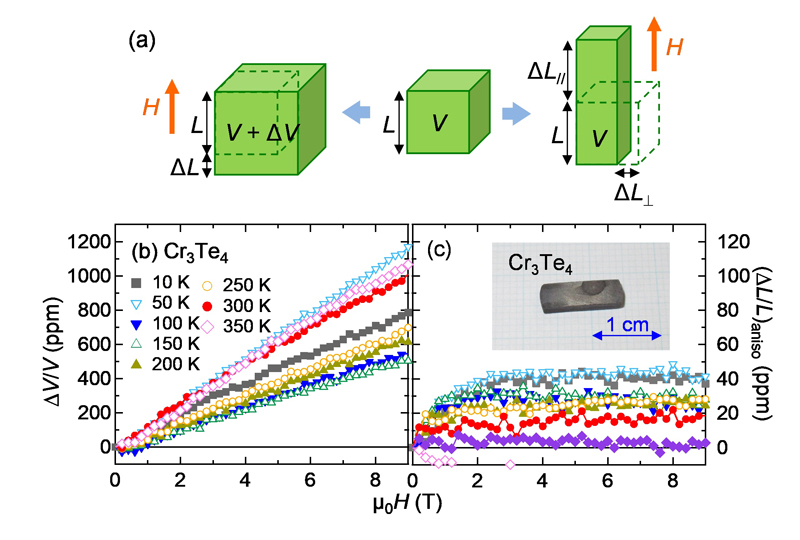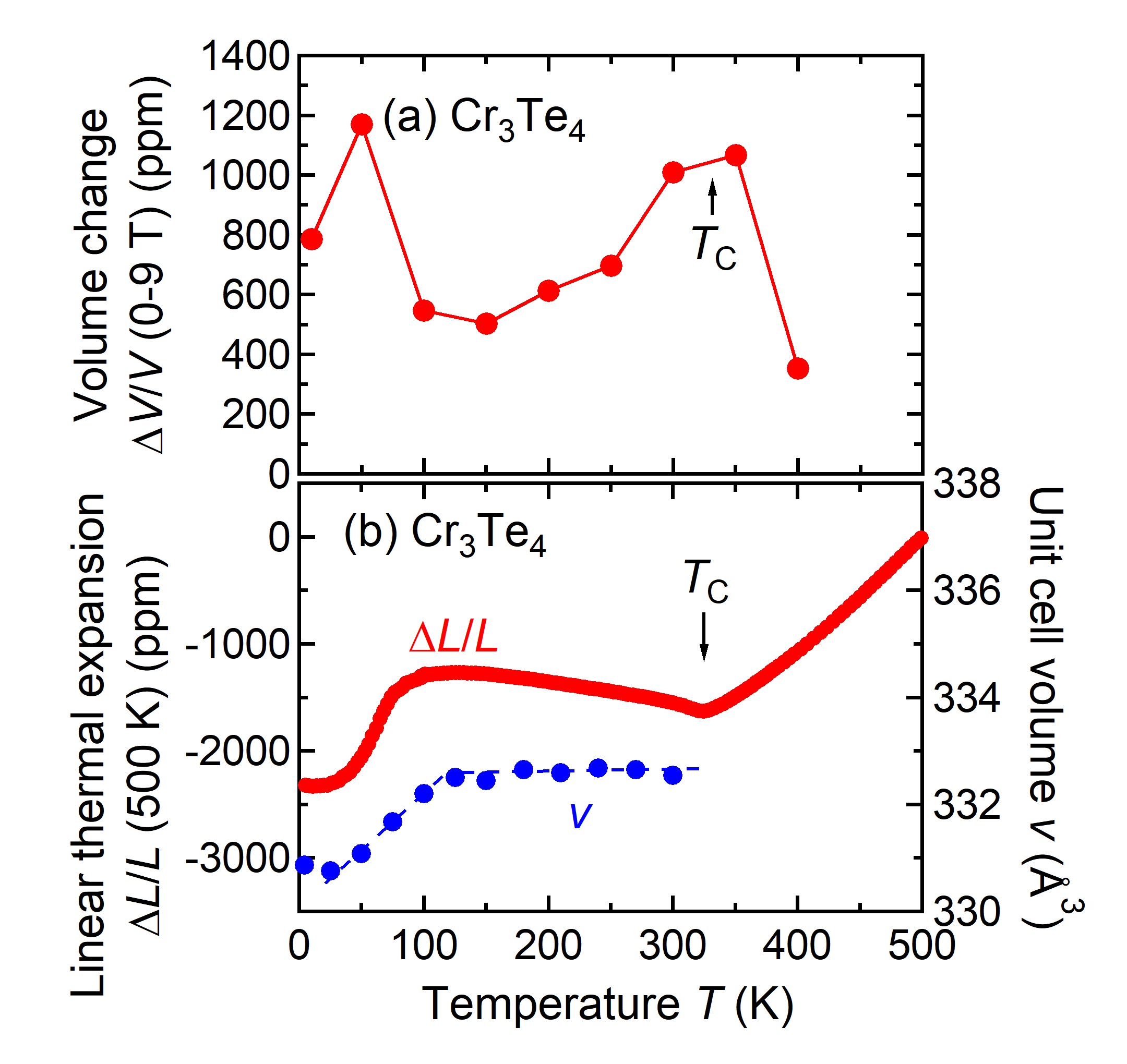Large Magnetic-Field-Induced Volume Change in Sintered Chromium Tellurides
Okamoto Group and X-Ray Diffraction Section
There is a long history in the study of magnetic-field-induced strains in ferromagnets. The most classical examples are iron and nickel, which show linear strains of several ppm to several tens of ppm by applying a magnetic field. The fact that their shapes can be changed by applying a magnetic field means that it can be used as an actuator that converts input energy or signal into mechanical movement. The small magnetostrictions in iron and nickel are insufficient for this application, but in 1960s, giant magnetostrictive materials such as Terfenol-D, exhibiting a large strain exceeding 2000 ppm, have been developed and used as a material for magnetostrictive actuators. In such magnetostrictions in ferromagnetic metals, the volume change is small. In contrast, there are a few materials that exhibit a large volume change in magnetic fields (forced volume magnetostriction), such as invar alloys. Invar alloys exhibit very small thermal expansion over a wide temperature range due to the magnetovolume effect, which also plays an important role in the manifestation of the large volume change in magnetic fields.
We have discovered large magnetic-field-induced volume changes in Cr-based magnets such as LiInCr4S8 and AgCrS2, which were hardly recognized as candidates for magnetostrictive materials [1,2]. Large volume increases reaching ΔV/V = 700 ppm under a magnetic field of 9 T were observed in LiInCr4S8 just below the Néel temperature of TN = 24 K and in AgCrS2 at TN = 42 K. Unlike invar alloys, these Cr-based magnets are antiferromagnetic insulators, suggesting that the large volume increases are caused by a complex interplay between the characteristic features of Cr spins, such as magnetic ordering accompanied by structural distortion, strong spin–lattice coupling, and geometrical frustration. However, the large volume changes were realized only at low temperature due to the low Néel temperatures, which is a disadvantage as a volume function. Therefore, we focused on Cr3Te4, which shows a ferromagnetic transition at a high temperature of TC = 330 K. Cr3Te4 is ferromagnetic unlike the above Cr sulfides but is promising if the characteristic features of Cr-based magnets are utilized. In fact, we found that Cr3Te4 sintered samples, shown in the inset of Fig. 1(c), show magnetic-field-induced strains accompanied by large volume changes in a wide temperature region including room temperature [3].

Fig. 1. (a) Isotropic (left) and anisotropic (right) magnetic-field-induced strains. (b) The volume changes in magnetic fields of a Cr3Te4 sintered sample measured at various temperatures. (c) The anisotropic strains in magnetic fields, corresponding to ΔL⊥ in the right panel of (a), of a Cr3Te4 sintered sample. The inset shows the Cr3Te4 sintered sample.
Figure 1 shows the linear strains in magnetic fields of a Cr3Te4 sintered sample measured at various temperatures. The strains in Cr3Te4 can be understood as the summation of two components that are isotropic strain with the volume change and anisotropic strain with the shape change shown in Fig. 1(a). The latter shows small values up to several tens of ppm, which correspond to the ferromagnetic magnetization curve, suggesting that Cr3Te4 showed usual behavior as a ferromagnet. In contrast, as shown in Fig. 1(b), the volume changes in magnetic fields are very large reaching ΔV/V =1200 ppm at a magnetic field of 9 T. This value is nearly twice as large as the maximum value of volume changes observed in Cr-based magnets as well as comparable to those of invar alloys. It is notable that a magnetic field of 9 T induced a significant volume change over 1000 ppm at room temperature and that the volume changes over 500 ppm throughout the entire temperature range below 350 K, as shown in Fig. 2(a).
The magnetic-field-induced volume changes in the Cr3Te4 sintered sample are particularly large near the Curie temperature, suggesting that the ferromagnetic order plays an essential role for the manifestation of the large volume increase. As shown in the linear thermal expansion shown in Fig. 2(b), a Cr3Te4 sintered sample showed a negative thermal expansion in a wide temperature range of 120–330 K below TC, where the volume increases with decreasing temperature. This result indicates that Cr3Te4 gradually changes from paramagnetic to ferromagnetic ordered states with decreasing temperature, implying that the ferromagnetic order is enhanced by applying a magnetic field in this temperature region, resulting in the large magnetic-field-induced volume change.
The thermal expansion of the Cr3Te4 sintered sample has another feature that the volume change associated with the ferromagnetic order does not match the volume change of a unit cell. As seen in the Fig 1(b), there is no temperature region where the unit cell volume increases with decreasing temperature. This discrepancy suggests that the negative thermal expansion in the Cr3Te4 sintered sample is due to the “mictrostructural effects”, discussed in β-eucryptite and Ca2RuO4, etc.[4,5] In Cr3Te4, the large magnetic-field-induced volume change and negative thermal expansion have the same origin that is the volume change at the ferromagnetic order, strongly suggesting that the microstructural effects play an important role in the emergence of the large magnetic-field-induced volume change. This is a different mechanism from the strong magnetovolume effect for invar alloys and might be a novel magneto-volume phenomenon occurring in Cr-based magnets.
References
- [1] T. Kanematsu, M. Mori, Y. Okamoto, T. Yajima, and K. Takenaka, J. Phys. Soc. Jpn. 89, 073708 (2020).
- [2] T. Kanematsu, Y. Okamoto, and K. Takenaka, Appl. Phys. Lett. 118, 142404 (2021).
- [3] Y. Kubota, Y. Okamoto, T. Kanematsu, T. Yajima, D. Hirai, and K. Takenaka, Appl. Phys. Lett. 122, 042404 (2023).
- [4] F. H. Gillery and E. A. Bush, J. Am. Ceram. Soc. 42, 175 (1959).
- [5] K. Takenaka, Y. Okamoto, T. Shinoda, N. Katayama, and Y. Sakai, Nat. Commun. 8, 14102 (2017).

